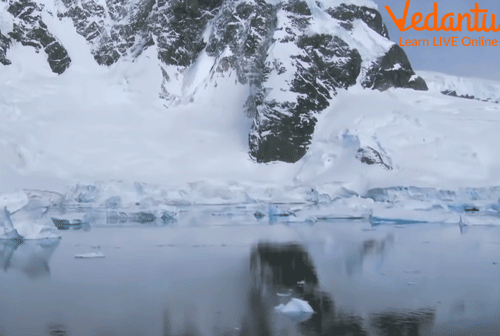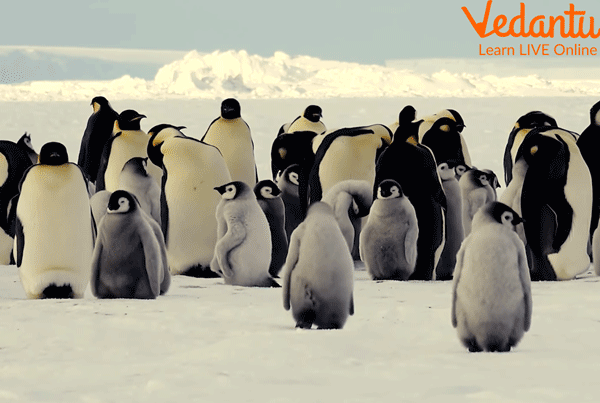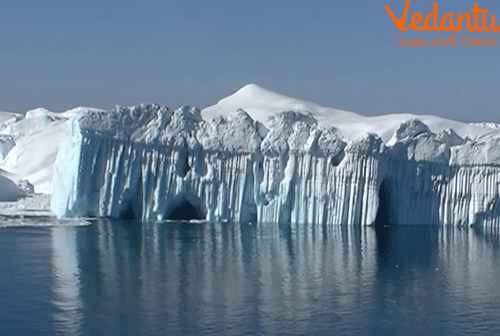




Why Is Antarctica Unique? Explore Its Climate, Animals, and More
Here we are going to learn about the cold and beautiful places of Antarctica. The continent of Antarctica makes up most of the Antarctic region. Antarctica is a remote, cold area in the Southern Hemisphere within the Antarctic Convergence. The Antarctic Convergence is an uneven line of latitude where cold, northward-flowing Antarctic waters meet the warmer waters of the world’s oceans. The Antarctic comprises approximately 20 percent of the Southern Hemisphere.
Antarctica is the fifth-largest continent in terms of area. It is larger than both Oceania and Europe combined. Antarctica is a unique continent because it has no native population. Although seven nations claim portions of it, there are no countries in Antarctica. Here, we will learn various important facts about Antarctica for kids and the features of Antarctica.

An Image Showing Antarctica’s Ice
Physical Features of Antarctica
The region is dominated by the Antarctic Ice Sheet. It is the single biggest chunk of ice known to exist. From roughly 3 million square kilometres (1.2 million square miles) at the end of summer to about 19 million square kilometres (7.3 million square miles) by winter. The Ross Ice Shelf and the Ronne Ice Shelf are the two coastal ice shelves where ice sheet expansion largely takes place.
The Transantarctic Mountains, which separate the continent's eastern and western portions, are one of the many peak tops in Antarctica. Several of these summits are over 4,500 metres in elevation (14,764 feet). The Antarctic Ice Sheet itself is located at the heart of the continent, where it rises to a height of 4,000 metres (13,123 feet) above sea level. Its elevation is around 2,000 metres (6,562 feet).
Older igneous and metamorphic rocks make up East Antarctica, often known as Greater Antarctica. Younger, volcanic, and sedimentary rocks make up West Antarctica, often known as Lesser Antarctica. In reality, the "Ring of Fire," a tectonically active region around the Pacific Ocean, includes Lesser Antarctica.
An essential physical feature of the Antarctica area is provided by the waters that surround Antarctica. The depth of the oceans surrounding Antarctica ranges from 13,123 to 16,404 feet (4,000 to 5,000 metres).

Penguins in Antarctica
First Sightings of Antarctica
The history of Antarctica dates back to the Greeks. Antarctica was originally far further north and had a tropical or semi-tropical climate, even though it is today a frozen wasteland. There, life abounded and forests bloomed.
Aristotle said that because the earth is spherical, there must be a landmass in the south to balance the land in the north. European navigators could not explore the Antarctic until the 18th century. He was assigned to a mission to the Southern Hemisphere between 1772 and 1775. Cook was the first person to traverse the Antarctic circle on January 17, 1773. He went over it.
An Estonian called Fabian von Bellinngsingshausen was the first person to view the continent of Antarctica on January 27, 1820. On January 30, 1820, Edward Bransfield became the second person to visit Antarctica. The South Orkney Islands were later found by George Powell and Nathaniel Palmer on December 6, 1821.
James Weddell, a Scot, also investigated the Weddell Sea in 1823. Charles Wilkes, an American, explored Antarctica in 1838–1839; Dumont d'Urville, a Frenchman, explored it in 1837–1840; and James Ross, a Scot, explored it in 1839–1841 The Ross Sea and Ross Ice Shelf were found by the latter.
Then, in 1892–1894, Carl Larson, a Norwegian, sailed to the southern continent. The first proof that Antarctica originally had a significantly warmer temperature was found by him—fossil wood. The Possession Islands were home to lichens when another Norwegian, Henrik Bull, discovered them in 1895.
Then, Adrien de Gerlache, a Belgian, conducted a second Antarctic trip in 1897–1898. Carsten Borchgrevink, a Norwegian, led a party of men that spent the winter in Antarctica from 1899–1900. They demonstrated that it was feasible to endure the brutal Antarctic winter. They were the first to bring dogs to Antarctica as well.

Iceberg in Antarctica
Climate of Antarctica
The climate of Antarctica is cold. The average yearly temperature in Antarctica varies from around 10°C along the shore to roughly 60°C in the interior's highest elevations.
The temperature can rise beyond +10°C in the summer and drop below 40°C in the winter close to the shore. It may go up to roughly 30°C over the higher inland in the summer but drop below 80°C in the winter.
The lowest temperature ever measured on the surface of the Earth was 89.2°C on July 21, 1983, at Vostok station.
A band of low pressure that has several low centres often encircles Antarctica. The phrase "circumpolar trough" describes this. But there is considerable pressure across the continent's interior. These circumstances create the ideal environment for Katabatic winds to emerge. Over a wide region, katabatic winds are quite consistent. They lose their energy near the coast and quickly evaporate offshore.
Summary
Antarctica is a colder region. When the air becomes extremely cold and dense due to radiative cooling over the high Antarctic ice sheet, Katabatic winds are produced. As it descends, the chilly, thick air is replaced with air that is subsiding from above. The meeting of glacier valleys causes the Katabatic winds to speed up and blow downward. The Transantarctic Mountains are one of the most beautiful places in Antarctica. Penguins are present in a good amount here in Antarctica.
Antarctica is made up of older igneous and metamorphic rocks. There is a temperature rise beyond +10°C in the summer and a drop below 40°C in the winter season near the shore. This makes Antarctica a unique place. Features of Antarctica, history of Antarctica, and climate of Antarctica.
FAQs on Fascinating Facts About Antarctica Every Student Should Know
1. What are some of the most interesting facts about Antarctica for kids?
Antarctica is a land of extremes! Here are a few cool facts:
- It is the coldest, windiest, and driest continent on Earth. Even though it's covered in ice, it's considered a desert because it gets very little rain or snow.
- About 98% of Antarctica is covered by a massive ice sheet that is, on average, over a mile thick.
- It is a continent for science and peace. No single country owns Antarctica, and it is reserved for research.
- It experiences six months of daylight in summer and six months of darkness in winter.
2. What makes Antarctica so different from all the other continents?
Antarctica is unique mainly because it's the only continent with no native human population. People don't live there permanently in towns and cities. The only inhabitants are visiting scientists living in research stations. It's also the highest continent on average, and it's almost entirely covered in a giant sheet of ice, which holds about 70% of the world's fresh water.
3. What kinds of animals live in the freezing environment of Antarctica?
Antarctica is home to animals that have adapted to the extreme cold. Most of them live near or in the ocean. You can find:
- Several species of penguins, like the Emperor and Adélie penguins.
- Different types of seals, such as the Weddell seal and the leopard seal.
- Large sea animals like whales, including the blue whale and orcas.
- Many seabirds and tiny shrimp-like creatures called krill, which are a very important food source.
You won't find any land animals like polar bears; they live in the Arctic!
4. How do animals like penguins manage to survive in such a cold place?
Animals in Antarctica have amazing adaptations to survive the cold. For example, penguins and seals have a thick layer of fat called blubber under their skin that works like a winter coat to keep them warm. Penguins also have tightly packed, waterproof feathers and huddle together in large groups to share body heat and protect themselves from the freezing wind.
5. What is the weather like in Antarctica?
The weather in Antarctica is the most extreme on Earth. It is incredibly cold, with winter temperatures dropping far below freezing. The continent is also known for its powerful winds, which can cause dangerous snowstorms called blizzards. Sometimes, the snow and clouds make it impossible to see the difference between the ground and the sky, a condition known as a whiteout.
6. Does anyone live in Antarctica?
No one lives in Antarctica permanently. There are no cities or towns. However, thousands of scientists and support staff from around the world live there temporarily at special research stations. They study everything from the climate and the ice to the unique animals that call Antarctica home.
7. Why is it important for us to protect Antarctica?
Protecting Antarctica is very important for the whole planet. The massive ice sheet helps keep our world cool by reflecting the sun's heat back into space. The ice also contains a record of Earth's past climate, helping scientists understand climate change. Protecting it means we are also saving the homes of the unique animals that live there and preserving a special place for science.









